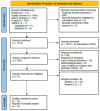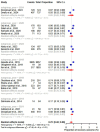Clinical Outcomes of Severe Lassa Fever in West Africa: A Systematic Review and Meta-Analysis
- PMID: 41154908
- PMCID: PMC12562845
- DOI: 10.3390/ijerph22101504
Clinical Outcomes of Severe Lassa Fever in West Africa: A Systematic Review and Meta-Analysis
Abstract
Lassa fever (LF) is an acute viral hemorrhagic fever that poses a substantial public health security threat in West Africa. The non-specific clinical presentation of LF, coupled with a lack of reliable point-of-care diagnostics, means delayed diagnosis, leading to severe complications and mortality during epidemics. A systematic review and meta-analyses were performed by conducting an extensive online search using PubMed, Web of Science, Scopus, CINAHL, and Google Scholar (PROSPERO protocol identifier number CRD42024587426). Only peer-reviewed studies written in English were included in publications from 1 September 2014, to 31 August 2024. The analysis and reporting followed PRISMA guidelines. The quality of the included studies was assessed using the critical appraisal tools developed from the Joanna Briggs Institute Systematic Review Checklist for cohort studies. We included 19 studies that contained data from 4177 patients hospitalized with LF of any age. Most included studies employed a retrospective cohort design and were conducted in Nigeria (16/19; 84.2%). The mortality rate was highest in a Sierra Leonean study (63.0%), whereas a group-based analysis of Nigerian studies using a random-effects model identified Owo as having the highest mortality rate of 13% (95% CI: 6-23; I2 = 98%). The pooled mortality rate for severe LF was 19% (95% confidence interval [CI]:10-32). The most common complications of LF are acute kidney injury (AKI) at a pooled proportion of 19% (95% CI; 13-26; I2 = 89%)), followed by abnormal bleeding at a pooled proportion of 17% (95% CI; 9-30; I2 = 98%), and central nervous system (CNS) dysfunction at a pooled proportion of 15% (95% CI; 6-32; I2 = 98%). With one out of every five hospitalized LF patients likely to die in West Africa, accelerating the development of rapid diagnostic tests, licensed vaccines, and novel therapeutics is crucial. Strengthening community engagement and risk communication, developing regional treatment guidelines, decentralizing LF care units, and training healthcare workers using a harmonized curriculum will enhance early diagnosis and effective case management, thereby reducing severe complications and mortality.
Keywords: CNS dysfunction; Lassa fever; West Africa; abnormal bleeding; acute kidney injury; mortality rate.
Conflict of interest statement
The authors declare no conflict of interest.
Figures


















References
-
- World Health Organization—Lassa Fever. [(accessed on 5 October 2024)]. Available online: https://www.who.int/news-room/fact-sheets/detail/lassa-fever.
-
- Adewuyi G.M., Fowotade A., Adewuyi B.T. Lassa Fever: Another Infectious Menace. Afr. J. Clin. Exp. Microbiol. 2009;10:144–155. doi: 10.4314/ajcem.v10i3.43407. - DOI
Publication types
MeSH terms
Grants and funding
LinkOut - more resources
Full Text Sources

